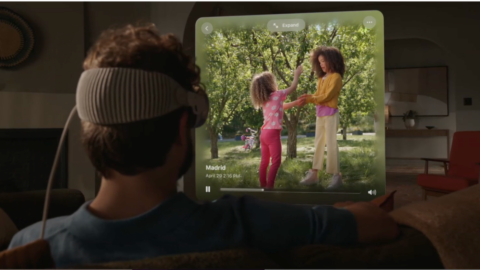According to Tim Cook, the era of spatial computing has arrived. The Apple Vision Pro, Apple’s newest tech offering, will be available in the U.S. on Feb. 2. To prepare for its launch, Apple has released guidelines for developing apps for the device’s App Store. Hidden within are delicious insights about what we can expect from the Apple Vision Pro.
Among the guidelines for proper capitalization (“visionOS begins with a lowercase v, even when it’s the first word in a sentence”) and minutiae practically begging to be ignored (“Don’t refer to Apple Vision Pro generically as a ‘headset'”) is this an interesting tidbit about how Apple intends to position its device within the market.

Apple says its Vision Pro will open a “new era of spatial computing.”
Credit: Apple
“Refer to your app as a spatial computing app,” the page reads. “Don’t describe your app experience as augmented reality (AR), virtual reality (VR), extended reality (XR), or mixed reality (MR).”
This distinction, while clunky, is a classic Apple marketing move.
Spatial computing isn’t exactly dinner party fare (the term has the potential to make a fellow guest’s eyes glaze over in the same way that “metaverse” may elicit eye rolls), but it also isn’t a term used by any of Apple’s competitors. Meta (and Oculus before it), Sony, HTC, and others have embraced “virtual reality” as a descriptor for their offerings. And despite their best efforts to legitimize the concept as compelling, a combination of factors — poor branding and marketing, niche use cases, uncomfortable headgear — have resulted in slow adoption and sales. Meta, and Mark Zuckerberg in particular, have turned virtual reality’s promise of otherwordly magic into a limbless joke.

The Apple Vision Pro’s promise of a “new era” wipes the slate clean of its bumbling predecessors.
Credit: Apple
These gaffes have made it hard to sell consumers on any kind of simulated reality, be it virtual, augmented, or extended. And to convince buyers that the Vision Pro is as integral to their daily existence as, say, the iPhone, Apple needs its device to be perceived as different and better than its dorky predecessors.
By declaring its take on VR as a new “era” completely void of, well, VR, Apple clears the slate. It corners the Google search market for the term “spatial computing” and lends an air of legitimacy to the whole project.
The general public may not know what spatial computing is, but the term sounds just complicated and futuristic enough to revive an industry limping towards irrelevance.
Topics
Apple
Virtual Reality
